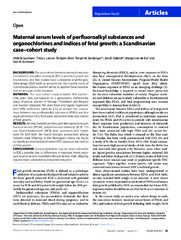Maternal serum levels of perfluoroalkyl substances and organochlorines and indices of fetal growth: a Scandinavian case-cohort study
Permanent link
https://hdl.handle.net/10037/10897DOI
doi:10.1038/pr.2016.187Date
2016-10-26Type
Journal articleTidsskriftartikkel
Peer reviewed
Author
Lauritzen, Hilde Brun; Larose, Tricia L; Øien, Torbjørn; Sandanger, Torkjel M; Odland, Jon Øyvind; van de Bor, Margot; Jacobsen, Geir WenbergAbstract
Background: The associations between prenatal exposure
to endocrine disruptive chemicals (EDCs) and fetal growth are
inconsistent, and few studies have considered small-for-gestational-age
(SGA) birth as an outcome. Our current study of
Scandinavian parous women aimed to address these inconsistencies
and gaps in the literature.
Methods: This case–cohort study included 424 mother– child pairs who participated in a prospective, multi-center study of parous women in Norway (Trondheim and Bergen) and Sweden (Uppsala). We used linear and logistic regression with 95% confidence intervals (CIs) to analyze the associations between two perfluoroalkyl substances (PFASs) and five organochlorines (OCs) from early second trimester and indices of fetal growth.
Results: Among Swedish women, prenatal exposure to perfluorooctanoate (PFOA), polychlorinated biphenyl (PCB) 153 and hexachlorobenzene (HCB) were associated with higher odds for SGA birth. We found stronger associations among Swedish male offspring. In the Norwegian cohort, we found no significant associations between EDC exposure and indices of fetal growth.
Conclusions: Some populations may be more vulnerable to EDCs, possibly due to differences in exposure levels, exposure sources and/or modifiable lifestyle factors. Male offspring may be more vulnerable to endocrine disruption.
Methods: This case–cohort study included 424 mother– child pairs who participated in a prospective, multi-center study of parous women in Norway (Trondheim and Bergen) and Sweden (Uppsala). We used linear and logistic regression with 95% confidence intervals (CIs) to analyze the associations between two perfluoroalkyl substances (PFASs) and five organochlorines (OCs) from early second trimester and indices of fetal growth.
Results: Among Swedish women, prenatal exposure to perfluorooctanoate (PFOA), polychlorinated biphenyl (PCB) 153 and hexachlorobenzene (HCB) were associated with higher odds for SGA birth. We found stronger associations among Swedish male offspring. In the Norwegian cohort, we found no significant associations between EDC exposure and indices of fetal growth.
Conclusions: Some populations may be more vulnerable to EDCs, possibly due to differences in exposure levels, exposure sources and/or modifiable lifestyle factors. Male offspring may be more vulnerable to endocrine disruption.
Description
© The Author(s) (2016). This work is licensed under a Creative Commons Attribution-NonCommercial-NoDerivs 4.0 International License. The images or other third party material in this article are included in the article’s Creative Commons license, unless indicated otherwise in the credit line; if the material is not included under the Creative Commons license, users will need to obtain permission from the license holder to reproduce the material.
DOI: 10.1038/pr.2016.187


 English
English norsk
norsk